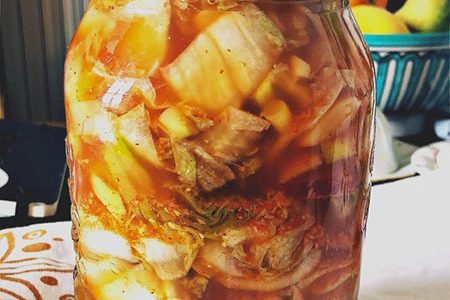The Kimchi Chinese cabbage or Baechu Kimchi it is the basic preparation of Kimchi. It is usually done in winter, with freshly picked cabbages and savoy cabbage, to have a supply even throughout the spring.
The beauty of Kimchi is that you can add vegetables to taste, roots and, after a few tries, create your own perfect combination. In some recipes you can also find some types of fish and crustaceans, which give precious essential amino acids to the Kimchi.
The Chinese Cabbage Kimchi recipe
Ingredients for a jar of about 1 liter
Vegetables need to be washed very very well.
500 grams of Chinese cabbage or Peking cabbage
250 grams of cabbage
150 grams of cabbage
4-5 radishes washed well and cut into thin slices
3 spring onions + minced garlic cloves (quantity to taste)
1 tablespoon of Korean Gochugaru chili; if you can't find it, you can replace it with good Italian chilli, in powder or very finely chopped.
30 grams fresh grated ginger (a generous spoonful)
some cabbage leaves
You can also add
julienne carrots, thinly sliced shallot, daikon.
For the brine, to be prepared in proportion to the weight of the vegetables
sea salt 90 grams (or whole sea salt)
still water (bottled) 1 liter
Equipment
1-2 very large ceramic or glass bowls.
1 glass jar with bayonet cap or the classic jars with screw cap.
Very large cabbage leaves or one or two zip-free freezer bags, filled with water. You will need them as a weight to keep the vegetables under the brine.
Or a vase with a bubbler and ceramic weights.
Gloves.
Method
Coarsely chop the Chinese cabbage and place it in a large bowl with the rest of the sliced vegetables.
Prepare the brine: dissolve the sea salt in a liter of water.
Pour the brine over the vegetables and push the vegetables well to the bottom. A weight can be used on top of a plate.
Leave to soak for about 6 hours.
In the meantime, prepare the spices: mix the ginger, chilli, chopped garlic and spring onions, trying to form a sort of paste to mix with the vegetables.
After the time has elapsed, drain the vegetables from the water, transfer them to a smaller bowl and mix them with the spices.
For this phase it is better to use latex gloves.
After mixing the spices with the vegetables well, transfer everything to a liter jar covered with brine.
Cover with the cabbage leaves. Place a zip-up freezer bag full of water over the leaves.
Vegetables must always be covered with brine.
Let it ferment at room temperature for 5 or 7 days, if it takes up to 14 days (tip: if it is the first time you prepare it, let it ferment for 5 or 7 days). At this point you can taste it, the flavor will be similar to pickles and will evolve more and more, as the days pass.
Transfer the Kimchi to smaller jars (the vegetables must always be covered with brine) and then to the refrigerator, where it can be kept for over 6 months.

